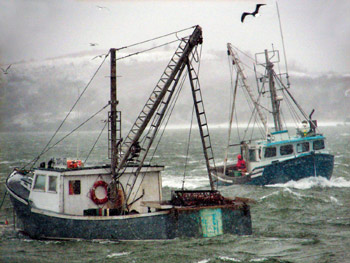Sectors: From The Trenches
by Mike Crowe
|
The New England Fisheries Management Council (NEFMC) met January 24, to hammer out what will be the foundation of a sector plan—that is allocation.
The volume of fish allowed to be taken is key to sustainability, in the eyes of the National Marine Fisheries Service (NMFS). The NEFMC, aware that its motion on sectors and the 2009 implementation date is an eleventh-hour one, was moving forward with it after a vote of support at the January 17 meeting. The option, waiting another year, as councilmen and fishermen generally agree, could see many more ground fishermen driven out of business and 400 hundred years of New England fishing changed forever.
In addition to the pressure from the National Marine Fisheries Service for the council to continue with the lethal days at sea (DAS) system, the service is pressing to extend the implementation date out to 2010. Fishermen know that between the number of days at sea dropping and a change in the policy dragged out to 2010, many of them will not be around to see the outcome.
In a two-page letter dated 12/7/07, addressed to John Pappalardo, NMFS Regional Director, Pat Kurkel wrote that she did not believe the council could have a sector plan within Amendment 16 for NMFS to implement by the May 1, 2009 deadline. She went on to say NMFS did not have the staff, science or money to for developing a sector plan for 2009. Pulling NMFS support for the council’s efforts got the council’s attention.
continue
|

The New England groundfish fleet is under enormous pressure from federal managers, weakened fish stocks, and economic realities. Consolidation of the fleet into a few fishing corporations is good for federal bureaucrats. It is a disaster for the hundreds of small boat fishermen, their families, the communities, and the many businesses they support. Chessie Johnson photo © 2007 |
|
|
|
|
Otis Enterprises Marine—Fiberglass is Forever
by Brenda Tredwell
|
“Fiberglass is forever. It never dies,” says Keith Otis, who’s set firmly into an office chair a floor above where FIRST TEAM dominates one bay of his shop. The time clock punctuates Otis’ words with an intermittent ka-dunk as he continues, “Those Liberty Boats the Navy was doing—those 34’s—most any harbor’s got a few still kicking around.”
First came the Webber Coves —“Jughead (Cy) Cousens trained REPCO (in fiberglass construction) and Glen Holland finished off both WEBBER COVES and REPCOS. Early on, there was Dave McGraw, Billings... Bruno & Stillman was a Granddaddy of fiberglass...” Otis’ head is cocked and he’s got his eyes fixed, as if he’s drawing a bead on a prowling target as he pulls things from memory.
“BHM—Big horny mother’s what we used to call them, they were the first to put engines in the floor instead of the cabin.” When Blue Hill Marine first came out with their design, there was a little skepticism about the under the floor engine placement—sometimes a guy would almost unintentionally walk around it. BHM did a 25', then a 31', then a 39'. They moved Blue Hill to Flye Point, becoming Flye Point Marine, then the business changed hands—and then the company was known as Atlantic Boat.
continue
|
| Lessons learned from the automotive industry led him to an appreciation of fiberglass—“light construction, efficient on fuel, not heavy like wood. It’s low maintenance.” Sam Murfitt photo |
|
|

